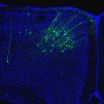(Press-News.org) DURHAM, N.C. -- When we want to listen carefully to someone, the first thing we do is stop talking. The second thing we do is stop moving altogether. This strategy helps us hear better by preventing unwanted sounds generated by our own movements.
This interplay between movement and hearing also has a counterpart deep in the brain. Indeed, indirect evidence has long suggested that the brain's motor cortex, which controls movement, somehow influences the auditory cortex, which gives rise to our conscious perception of sound.
A new Duke study, appearing online August 27 in Nature, combines cutting-edge methods in electrophysiology, optogenetics and behavioral analysis to reveal exactly how the motor cortex, seemingly in anticipation of movement, can tweak the volume control in the auditory cortex.
The new lab methods allowed the group to "get beyond a century's worth of very powerful but largely correlative observations, and develop a new, and really a harder, causality-driven view of how the brain works," said the study's senior author Richard Mooney Ph.D., a professor of neurobiology at Duke University School of Medicine, and a member of the Duke Institute for Brain Sciences.
The findings contribute to the basic knowledge of how communication between the brain's motor and auditory cortexes might affect hearing during speech or musical performance. Disruptions to the same circuitry may give rise to auditory hallucinations in people with schizophrenia.
In 2013, researchers led by Mooney first characterized the connections between motor and auditory areas in mouse brain slices as well as in anesthetized mice. The new study answers the critical question of how those connections operate in an awake, moving mouse.
"This is a major step forward in that we've now interrogated the system in an animal that's freely behaving," said David Schneider, a postdoctoral associate in Mooney's lab.
Mooney suspects that the motor cortex learns how to mute responses in the auditory cortex to sounds that are expected to arise from one's own movements while heightening sensitivity to other, unexpected sounds. The group is testing this idea.
"Our first step will be to start making more realistic situations where the animal needs to ignore the sounds that its movements are making in order to detect things that are happening in the world," Schneider said.
In the latest study, the team recorded electrical activity of individual neurons in the brain's auditory cortex. Whenever the mice moved -- walking, grooming, or making high-pitched squeaks -- neurons in their auditory cortex were dampened in response to tones played to the animals, compared to when they were at rest.
To find out whether movement was directly influencing the auditory cortex, researchers conducted a series of experiments in awake animals using optogenetics, a powerful method that uses light to control the activity of select populations of neurons that have been genetically sensitized to light. Like the game of telephone, sounds that enter the ear pass through six or more relays in the brain before reaching the auditory cortex.
"Optogenetics can be used to activate a specific relay in the network, in this case the penultimate node that relays signals to the auditory cortex," Mooney said.
About half of the suppression during movement was found to originate within the auditory cortex itself. "That says a lot of modulation is going on in the auditory cortex, and not just at earlier relays in the auditory system" Mooney said.
More specifically, the team found that movement stimulates inhibitory neurons that in turn suppress the response of the auditory cortex to tones.
The researchers then wondered what turns on the inhibitory neurons. The suspects were many. "The auditory cortex is like this giant switching station where all these different inputs come through and say, 'Okay, I want to have access to these interneurons,' " Mooney said. "The question we wanted to answer is who gets access to them during movement?"
The team knew from previous experiments that neuronal projections from the secondary motor cortex (M2) modulate the auditory cortex. But to isolate M2's relative contribution -- something not possible with traditional electrophysiology -- the researchers again used optogenetics, this time to switch on and off the M2's inputs to the inhibitory neurons.
Turning on M2 inputs reproduced a sense of movement in the auditory cortex, even in mice that were resting, the group found. "We were sending a 'Hey I'm moving' signal to the auditory cortex," Schneider said. Then the effect of playing a tone on the auditory cortex was much the same as if the animal had actually been moving -- a result that confirmed the importance of M2 in modulating the auditory cortex. On the other hand, turning off M2 simulated rest in the auditory cortex, even when the animals were still moving.
"I couldn't contain my excitement when we first saw that result," said Anders Nelson, a neurobiology graduate student in Mooney's group.
INFORMATION:
The work was supported by the Helen Hay Whitney Foundation, the Holland-Trice Graduate Fellowship in Brain Sciences, and the National Institutes of Health (NS079929).
CITATION: " A synaptic and circuit basis for corollary discharge in the auditory cortex," David M. Schneider, Anders Nelson, Richard Mooney. Nature, August 27, 2014. DOI: 10.1038/nature13724
Stop and listen: Study shows how movement affects hearing
Brain's motor areas can directly turn down hearing
2014-08-27
ELSE PRESS RELEASES FROM THIS DATE:
NASA sees massive Marie close enough to affect southern California coast
2014-08-27
Two NASA satellites captured visible and infrared pictures that show the massive size of Hurricane Marie. Marie is so large that it is bringing rough surf to the southern coast of California while almost nine hundred miles west of Baja California.
On August 26 at 19:05 UTC (3:05 p.m. EDT) NASA's Terra satellite captured a visible image of Hurricane Marie drawing in the small remnants of Karina. Marie is over 400 miles in diameter, about the distance from Washington, D.C. to Boston, Massachusetts. Hurricane force winds extend outward up to 60 miles (95 km) from the center ...
Scripps Research Institute scientists link alcohol-dependence gene to neurotransmitter
2014-08-27
LA JOLLA, CA – August 27, 2014 – Scientists at The Scripps Research Institute (TSRI) have solved the mystery of why a specific signaling pathway can be associated with alcohol dependence.
This signaling pathway is regulated by a gene, called neurofibromatosis type 1 (Nf1), which TSRI scientists found is linked with excessive drinking in mice. The new research shows Nf1 regulates gamma-aminobutyric acid (GABA), a neurotransmitter that lowers anxiety and increases feelings of relaxation.
"This novel and seminal study provides insights into the cellular mechanisms of ...
Expression of privilege in vaccine refusal
2014-08-27
DENVER (August 27, 2014) – Not all students returning to school this month will be up to date on their vaccinations. A new study conducted by Jennifer Reich, a researcher at the University of Colorado Denver, shows that the reasons why children may not be fully vaccinated depends on the class privilege of their mothers.
According to the National Network for Immunization Information, three children per 1000 in the U.S. have never received any vaccines, with almost half of all children receiving vaccines later than recommended. The number of unvaccinated children has led ...
Dosage of HIV drug may be ineffective for half of African-Americans
2014-08-27
Many African-Americans may not be getting effective doses of the HIV drug maraviroc, a new study from Johns Hopkins suggests. The initial dosing studies, completed before the drug was licensed in 2007, included mostly European-Americans, who generally lack a protein that is key to removing maraviroc from the body. The current study shows that people with maximum levels of the protein — including nearly half of African-Americans — end up with less maraviroc in their bodies compared to those who lack the protein even when given the same dose. A simple genetic test for the ...
Scientists plug into a learning brain
2014-08-27
Learning is easier when it only requires nerve cells to rearrange existing patterns of activity than when the nerve cells have to generate new patterns, a study of monkeys has found. The scientists explored the brain's capacity to learn through recordings of electrical activity of brain cell networks. The study was partly funded by the National Institutes of Health.
"We looked into the brain and may have seen why it's so hard to think outside the box," said Aaron Batista, Ph.D., an assistant professor at the University of Pittsburgh and a senior author of the study published ...
Pitt and Carnegie Mellon engineers discover why learning can be difficult
2014-08-27
PITTSBURGH—Learning a new skill is easier when it is related to ability that we already possess. For example, a trained pianist might learn a new melody more easily than learning how to hit a tennis serve.
Neural engineers from the Center for the Neural Basis of Cognition (CNBC)—a joint program between the University of Pittsburgh and Carnegie Mellon University—have discovered a fundamental constraint in the brain that may explain why this happens. Published as the cover story in the Aug. 28, 2014, issue of Nature, they found for the first time that there are constraints ...
Kessler Foundation scientists study impact of cultural diversity in brain injury research
2014-08-27
West Orange, NJ. August 27, 2014. Kessler Foundation scientists examined the implications for cultural diversity and cultural competence in brain injury research and rehabilitation. The article by Anthony Lequerica, PhD, and Denise Krch, PhD: Issues of cultural diversity in acquired brain injury (ABI) rehabilitation (doi:10.3233/NRE-141079) was published by Neurorehabilitation. Drs. Lequerica and Krch are research scientists in Traumatic Brain Injury (TBI) Research at Kessler Foundation and co-investigators for the Northern New Jersey TBI Model System.
Cultural sensitivity ...
New smartphone app can detect newborn jaundice in minutes
2014-08-27
Newborn jaundice: It's one of the last things a parent wants to deal with, but it's unfortunately a common condition in babies less than a week old.
Skin that turns yellow can be a sure sign that a newborn is jaundiced and isn't adequately eliminating the chemical bilirubin. But that discoloration is sometimes hard to see, and severe jaundice left untreated can harm a baby.
University of Washington engineers and physicians have developed a smartphone application that checks for jaundice in newborns and can deliver results to parents and pediatricians within minutes. ...
Parents, listen next time your baby babbles
2014-08-27
Pay attention, mom and dad, especially when your infant looks at you and babbles.
Parents may not understand a baby's prattling, but by listening and responding, they let their infants know they can communicate which leads to children forming complex sounds and using language more quickly.
That's according to a new study by the University of Iowa and Indiana University that found how parents respond to their children's babbling can actually shape the way infants communicate and use vocalizations.
The findings challenge the belief that human communication is innate ...
Lifetime of fitness: A fountain of youth for bone and joint health?
2014-08-27
ROSEMONT, Ill.—Being physically active may significantly improve musculoskeletal and overall health, and minimize or delay the effects of aging, according to a review of the latest research on senior athletes (ages 65 and up) appearing in the September issue of the Journal of the American Academy of Orthopaedic Surgeons (JAAOS).
It long has been assumed that aging causes an inevitable deterioration of the body and its ability to function, as well as increased rates of related injuries such as sprains, strains and fractures; diseases, such as obesity and diabetes; and ...
LAST 30 PRESS RELEASES:
New software sheds light on cancer’s hidden genetic networks
UT Health San Antonio awarded $3 million in CPRIT grants to bolster cancer research and prevention efforts in South Texas
Third symposium spotlights global challenge of new contaminants in China’s fight against pollution
From straw to soil harmony: International team reveals how biochar supercharges carbon-smart farming
Myeloma: How AI is redrawing the map of cancer care
Manhattan E. Charurat, Ph.D., MHS invested as the Homer and Martha Gudelsky Distinguished Professor in Medicine at the University of Maryland School of Medicine
Insilico Medicine’s Pharma.AI Q4 Winter Launch Recap: Revolutionizing drug discovery with cutting-edge AI innovations, accelerating the path to pharmaceutical superintelligence
Nanoplastics have diet-dependent impacts on digestive system health
Brain neuron death occurs throughout life and increases with age, a natural human protein drug may halt neuron death in Alzheimer’s disease
SPIE and CLP announce the recipients of the 2025 Advanced Photonics Young Innovator Award
Lessons from the Caldor Fire’s Christmas Valley ‘Miracle’
Ant societies rose by trading individual protection for collective power
Research reveals how ancient viral DNA shapes early embryonic development
A molecular gatekeeper that controls protein synthesis
New ‘cloaking device’ concept to shield sensitive tech from magnetic fields
Researchers show impact of mountain building and climate change on alpine biodiversity
Study models the transition from Neanderthals to modern humans in Europe
University of Phoenix College of Doctoral Studies releases white paper on AI-driven skilling to reduce burnout and restore worker autonomy
AIs fail at the game of visual “telephone”
The levers for a sustainable food system
Potential changes in US homelessness by ending federal support for housing first programs
Vulnerability of large language models to prompt injection when providing medical advice
Researchers develop new system for high-energy-density, long-life, multi-electron transfer bromine-based flow batteries
Ending federal support for housing first programs could increase U.S. homelessness by 5% in one year, new JAMA study finds
New research uncovers molecular ‘safety switch’ shielding cancers from immune attack
Bacteria resisting viral infection can still sink carbon to ocean floor
Younger biological age may increase depression risk in older women during COVID-19
Bharat Innovates 2026 National Basecamp Showcases India’s Most Promising Deep-Tech Ventures
Here’s what determines whether your income level rises or falls
SCIE indexation achievement: Celebrate with Space: Science & Technology
[Press-News.org] Stop and listen: Study shows how movement affects hearingBrain's motor areas can directly turn down hearing






